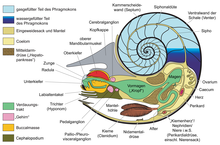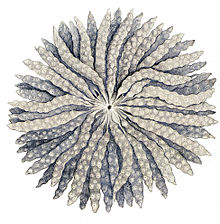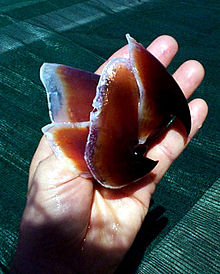Cephalopod
![]()
The title of this article is ambiguous. For the painting style of children, see Children's drawing #Cophalopod.
The zoological class of cephalopods (Cephalopoda, from ancient Greek κεφαλή kephalē "head" and ποδ- pod- "foot") is a group of animals belonging to the molluscs (Mollusca) and found only in the sea. There are both pelagic (free-swimming) and benthic (bottom-dwelling) species. There are currently about 30,000 extinct species and 1,000 species known to be alive today. Cephalopods include the largest living mollusks. The largest giant squid found to date was 13 meters long. The extinct ammonites reached a shell size of up to two meters.
The name "Cephalopoda" was introduced by Georges Cuvier in 1797, replacing the older term "polyps" (πολύπους polýpous "many-footed creatures") handed down by ancient authors such as Aristotle and Pliny, which Réaumur had applied to cnidarians in 1742 and which is used exclusively in this sense in modern zoology.
Anatomy
Structure of the body
Cephalopods have a body consisting of a trunk part (with visceral sac), a head part with attached arms and a pocket-shaped mantle located on the ventral side. The orientation of the body division does not correspond to the preferred direction of locomotion. In cephalopods, the anterior part of the foot is developed into a funnel and eight, ten or more than 90 tentacles. The cavity of the mantle, called the mantle cavity, usually contains two (in the Nautiloidea: four) gills and opens outward through a tube (called a hyponom or funnel). The mouth is surrounded by extendable tentacles. The mouth of recent species has a parrot-like beak with upper and lower jaws and a rasping tongue (radula).
Shell, hard parts and floats
The more primitive species, such as the nautiloids and the extinct ammonites, are outer-shelled: a calcareous shell of aragonite gives them protection and support as an outer skeleton. The shell of this case is three-layered. Underneath the outer periostracum, the shell membrane made of the glycoprotein conchin, lies the outer prismatic layer (ostracum) of prismatic aragonite. The inner layer, the hypostracum, consists of nacre, like the septa.
The shells are divided into the actual living chamber and a section with gas-filled chambers (phragmocone). With the help of this gas-filled part, the housing can be kept suspended in the water column. However, today's nautilus (pearl boat) cannot use the shell to ascend and descend in the water column, since too little water can be pumped into or out of the shell in each case (about five grams), but it moves along (also vertically in the water column) with the help of the recoil principle of the funnel. In the case of the extinct ammonites, however, it has recently been discussed whether it was not possible for this group to move up and down in the water column by changing the volume of gas or water in the chambers. However, the internal structures of the shells of Nautiloidea and Ammonoidea are also very different.
The outer-shelled cephalopods are only represented by the five or six species of the genus Nautilus. One species is also considered by some researchers to represent a separate genus (Allonautilus). From the fossil record, over 10,000 species of extinct nautiloids (pearlboat-like) have been described. The number of extinct ammonites has not yet been accurately recorded, but is likely to be in the order of about 30,000-40,000.
With the inside-shelled cephalopods, the hard-parts are enclosed by the mantle:
- The extinct belemnites successively reduced the living chamber to a dorsal spoon or rod (proostracum).
- Spirula has a spiral of calcium carbonate oriented towards the abdomen, in contrast to ammonites and nautilus, which is divided into individual gas-filled chambers.
- The Sepien still put the original septa, that originally stood approximately perpendicularly to the longitudinal-axis of the housing, strongly obliquely and converted to a Schulp, that still has buoyancy-function, however.
- The squids, on the other hand, have reduced the original calcareous shell to a horny, elongated strip (gladius) in the mantle with the loss of mineralization and thus buoyancy, which only supports the body.
- In octopuses, the former shell is reduced to cartilage-like relic structures or even completely.
Squids and octopuses have partly developed alternative buoyancy systems (ammonia, oily substances, etc.). In today's seas, the inner-shelled cephalopods (Coleoidea or also Dibranchiata) dominate.
Nervous system
The nervous system of cephalopods is the most powerful among both molluscs and invertebrates. This is especially true of the modern cephalopods (Coleoidea), in which the large neural ganglia (cerebral ganglia, pedal ganglia, pleural ganglia) are fused into a complex structure that can be called a brain. The nervous system of ten-armed octopuses (Decabrachia) is also characterized by giant axons whose transmission speed approaches that of vertebrate axons. Experiments with severed octopus arms showed that the arms have their own, autonomously acting nerve centres, through which certain reflexes, for example when searching for food or hunting, can be triggered independently of the brain. The paired eyes on the side of the head of nautilids function according to the pinhole camera principle. Modern cephalopods have everse (equipped with light-facing photoreceptors in the retina) and ontogenetically inverted lens eyes analogous to the inverse (equipped with light-facing photoreceptors in the retina) and ontogenetically inverted lens eyes of vertebrates, which is a classic example of convergent evolution. For rapid processing of optical stimuli, the cephalopod brain has large optical lobes.
Furthermore, cephalopods possess highly developed statocysts, which lie to the side of the brain and can perceive relatively low-frequency sound in addition to gravity and acceleration.
Cephalopods are considered the most intelligent invertebrates. Behavioural experiments show that the cognitive abilities of octopuses partly approach those of dogs. They are capable of abstraction (for example, counting to 4 or distinguishing different shapes) and solving complex problems (including opening the screw cap of a jar to access the contents).

Historical drawing of a cuttlefish (Sepia officinalis, a member of the octopus family) dissected from the ventral side

Longitudinal section through the shell of a pearl boat (nautilus) with living chamber and chambered phragmocone

Nervous system of a cuttlefish (historical representation from 1876)

Schematic longitudinal section of nautilus with soft tissues
Physiology
Locomotion
As active predators, cephalopods rely primarily on locomotion according to the recoil principle. Here, the space between the head and the mantle wall, and thus also the volume of the mantle cavity, is reduced in most representatives by the contraction of the ring muscles of the mantle. As a result of the resulting overpressure in the mantle cavity, the water is forced out through the funnel, causing the body to move in the opposite direction. By changing the position of the funnel, the direction of locomotion can be varied. The lateral fins are used for stabilization in squid and for "hovering" and propulsion by wave-like fin flapping in cuttlefish, whose lateral fins line a large portion of the mantle. Octopods are associated with the sea floor (benthos) and crawl using their tentacles. However, they also use recoil propulsion when escaping.
Circulation
Cephalopods are the only molluscs that have a closed circulatory system. Blood in coleoids is pumped to the gills through two gill hearts located at the base of the gills. This results in high blood pressure and rapid blood flow and is necessary to support the relatively high metabolic rates of cephalopods. At the gills, oxygenation of the blood occurs. The now oxygenated blood is pumped to the rest of the body by a systemic heart.
Breathe
Gills are the primary respiratory organs of cephalopods. A large gill surface and a very thin tissue (respiratory epithelium) of the gill provide an effective gas exchange of both oxygen and carbon dioxide. Because the gills are located in the mantle cavity, this type of respiration is coupled to movement. In squid and octopods, an albeit lesser part of respiration has been attributed to the skin. As in many molluscs, oxygen transport in the blood of cephalopods is not by iron-containing hemoglobins (as in vertebrates, among others), but by copper-containing hemocyanins. Furthermore, hemocyanins are not located in special cells (like hemoglobins in red blood cells), but are freely present in the blood plasma. If hemocyanins are not loaded with oxygen, they appear transparent and take on a blue color when they bind with oxygen.
Nutrition and digestion
With the exception of the detritus-eating vampire cuttlefish, cephalopods are active predators that live exclusively on animal food. The prey is visually perceived and grasped with the tentacles, which are equipped with suction cups. In squid, these suckers are equipped with small hooks. Cuttlefish and nautilus feed mainly on small invertebrates living on the seabed. Squid prey includes fish and shrimp, which are paralyzed by a bite to the neck. Octopods are nocturnal hunters and prey mainly on snails, crustaceans and fish. To effectively kill their prey, octopods possess a paralyzing venom that is injected into the prey. After being ingested by means of parrot-beak-like jaws (made of chitin, among other things), the food enters the muscular digestive tract. The food is moved by peristaltic movements of the digestive tract and digested mainly in the stomach and appendix. After passing through the intestine, undigested food leaves the body through the anus and passes out through the funnel as water is expelled from the mantle cavity.
Reproduction
Many cephalopods have a pronounced sexual behavior. Usually, after extensive foreplay, the male releases his sperm, packed in spermatophores, into the mantle cavity of the female with one arm, the hectocotylus. In paper boats, however, the hectocotylus detaches from the male and actively swims, attracted by chemical messengers from the female (chemotaxis), into her mantle cavity. The female's eggs are fertilized as they emerge from the oviduct and may be deposited in clusters (cuttlefish, octopus), or in tubes (squid), which contain a large number of eggs. The female lays voluminous and extremely yolk-rich eggs. During embryonic development, the embryo feeds on the stored energy in the yolk. Female octopods clean the laid eggs with their tentacles and water thrusts.
Furrowing during embryogenesis is partial-discoid and causes the developing embryo to grow around the yolk. In the process, part of the yolk mass is displaced inward (inner yolk sac); an often larger part of the yolk mass associated with the inner yolk sac (outer yolk sac) remains outside the embryo. Hatching occurs after or even before the outer yolk has been used up. The inner yolk serves as a food reserve for the period between hatching and complete conversion to independently preyed upon food. After hatching, adult cephalopods do not care for their offspring.
Dyes and bioluminescence
Cephalopods have special skin cells called chromatophores. These contain a pigment (dye) and are surrounded by tiny muscles that attach to these skin cells. When these muscles are tensed, a chromatophore cell expands, changing the color at that location on the body. The selective expansion and contraction of chromatophores allows the color and pattern of the skin to change. This plays an important role in camouflage, warning, and mating behavior, among other things. For example, in stressful situations, cuttlefish run color stripes across their bodies in a wave-like manner and can adapt to a checkerboard in color and pattern.
With the help of brown or black ink (consisting of melanin and other chemical substances) cephalopods can scare and deceive their predators. The ink gland is located behind the anus and discharges the ink through the mantle cavity and further out through the funnel. Furthermore, in Sepia officinalis, for example, the many layers of the egg shell are provided with ink, which thus provides camouflage for the embryos.
Within the squid, over 70 genera with bioluminescence are known. In several genera, this is produced with the aid of symbiotic bacteria; in the other genera, however, it is produced by a reaction of luciferin and oxygen with the aid of the enzyme luciferase. Cells that bioluminesce in this manner, called photophores, may serve camouflage and mating behavior (in deep-sea octopods). In addition, bioluminescent particles can be ejected with the ink.

Egg tubes of the common squid

Parrot beak-like jaws of a giant squid
Questions and Answers
Q: What is the Cephalopoda?
A: The Cephalopoda is an important mollusc class that has bilateral symmetry, a head, and arms or tentacles.
Q: What does Teuthology refer to?
A: Teuthology is a branch of malacology, which studies cephalopods.
Q: How many living subclasses does the Cephalopoda have?
A: The Cephalopoda has two living subclasses.
Q: What is the difference between the two living subclasses of Cephalopoda?
A: In the Coleoidea subclass, the mollusc shell has either become smaller, or is not present at all, which includes octopus, squid, and cuttlefish. The Nautiloidea subclass has a shell, and Nautilus is the only living genus.
Q: How many living species of Cephalopoda are there?
A: There are at least 800 different living species of Cephalopods.
Q: What are the two important extinct taxa of Cephalopoda?
A: The two important extinct taxa of Cephalopoda are Ammonites and Belemnites (order Belemnoidea, of class Coleoidea).
Q: Where can Cephalopods be found?
A: Cephalopods can be found in all oceans of the world, and at all pelagic levels. None of them can live in freshwater, but a few species live in brackish (partly salty) water.
Search within the encyclopedia